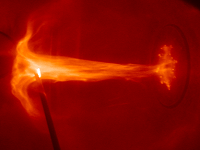Heating and Compression Mechanisms for Fusion

Technology Description:
Caltech, in coordination with Los Alamos National Laboratory (LANL), will investigate the scaling of adiabatic heating of plasma by propelling magnetized plasma jets into stationary heavy gases and/or metal walls. This is the reverse of the process that would occur in an actual fusion reactor – where a gas or metal liner would compress the plasma – but will provide experimental data to assess the magneto-inertial fusion approach. By using this alternative frame of reference, the researchers will be able to conduct experiments more frequently and at a lower cost because the experimental setup is non-destructive. The team will investigate the jet-target collision using many experiments with a wide range of parameters to determine the actual equation of state relating compression, change in magnetic field, and temperature increase. The experimental work will be supplemented with advanced 3D computer models. If successful, these results will show that compressional heating by a liner is a viable method for increasing temperatures to the levels required for magneto-inertial fusion. The study will also provide critical information on the interactions and limitations for a variety of possible driver and plasma target combinations being developed across the ALPHA program portfolio.
Potential Impact:
If successful, Caltech and LANL’s work will yield experimental results that show magneto-inertial fusion is a low-cost, viable path to economical fusion power production.
Security:
Caltech’s innovations could accelerate the development of cost-effective fusion reactors, which could provide a nearly limitless supply of domestic power and eliminate dependence on foreign sources of energy and limited fuel supplies.
Environment:
Fusion reactors offer nearly zero emissions and produce manageable waste products. If widely adopted, they could significantly reduce or nearly eliminate carbon emissions from the power production sector.
Economy:
Magneto-inertial fusion, if viable, could enable a low-cost path to fusion, reducing research costs to develop economical reactors.
Contact
ARPA-E Program Director:
Dr. Patrick McGrath
Project Contact:
Dr. Paul Bellan
Press and General Inquiries Email:
ARPA-E-Comms@hq.doe.gov
Project Contact Email:
pbellan@caltech.edu
Partners
Los Alamos National Laboratory
Related Projects
Release Date:
08/24/2014
